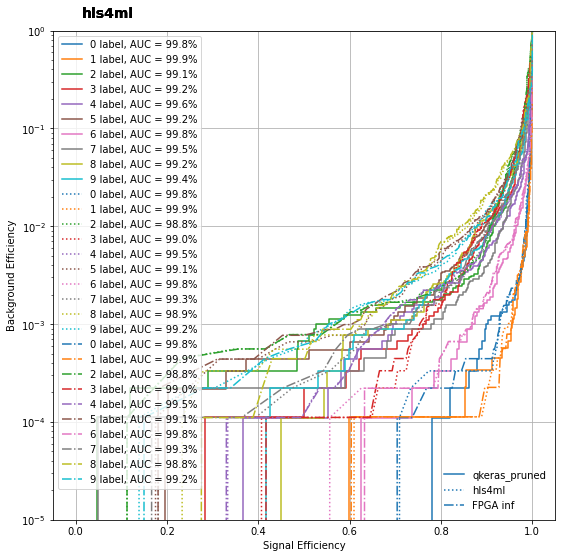Here are presented two examples of FPGA neural network inference, namely the jet tagging and MNIST classification.
It is used hls4ml 0.6.0 version,to install it run the following command (with also the profiling features):
pip install hls4ml[profiling]
The files are organized as follows
NN_train: which contains the notebooks used to create and save the Keras and Qkeras models.PYNQ_files: which contains the .bit and .hwh files needed to load the overlay (exported from Vivado 2020.1) and the notebooks ran on the board.
The tests are performed on a PYNQ-Z2 board equipped with xc7z020clg400-1 ZYNQ FPGA.
Here are presented the resources estimated by vivado and the actual utilization on the optimized model.
| Model | BRAM[%] | DSP[%] | FF[%] | LUT[%] |
|---|---|---|---|---|
| Vanilla | 45 | 123 | 31 | 101 |
| Quntized+Pruned | 18 | 91 | 20 | 114 |
| FPGA implementation | 3 | 87 | 17 | 34 |
| Model | BRAM[%] | DSP[%] | FF[%] | LUT[%] |
|---|---|---|---|---|
| Vanilla | - | - | - | - |
| Quntized+Pruned | 41 | 4 | 24 | 109 |
| FPGA implementation | 33 | 5 | 21 | 35 |
| Model | BRAM[%] | DSP[%] | FF[%] | LUT[%] |
|---|---|---|---|---|
| Vanilla | - | - | - | - |
| Quntized+Pruned | 149 | 4 | 49 | 325 |
| FPGA implementation | 68 | 5 | 47 | 68 |
| Device | timgCNN[μs] | timgDNN[μs] |
|---|---|---|
| CPU[3700X] | 95 | 24 |
| GPU[RX 580] | 30 | 22 |
| ZYNQ[PYNQ_Z2] | 87 | 85 |
| ALVEO[u50] | 21 | 9 |
As it is clear the main bottlenecks are the PS-PL interface (AXIS DMA), to transfer and to read back a single frame at least 60 microsendos are required, this number is found with a large transfer (10000 frames), with a smaller buffer size the time per image will degrade.

